
Painting by Italian painter Sebastian Ricci “Childhood of Tsar Cyrus the Great”. The size of the painting is 259 x 201 cm, oil on canvas. Cyrus II the Great, founder of the Persian kingdom of the Achaemenids, reigned from 558 BC. e. The accession of Cyrus in the “History” of Herodot is preceded by a legend about his wonderful birth and childhood. Grandpa Kira, king of the Medes Astyages, received in a dream a prediction that his grandson would deprive him of his power and become the founder of a great power.
The king gave the order to take the baby away from the daughter and kill him, but the child was saved by a simple shepherd and accepted into his family. The legend tells that later Astyages recognized his grandson as a shepherd boy and sent Cyrus to the far reaches of the Medes, in Persia, where his real father lived, the ruler of the Persians named Kambis. In 558 BC. e. Cyrus II became king of Persia; in five years in 553 BC e. He prompted the Persian tribes to rebel against the Medes and, having seized the capital of the Medes of Ecbatana, deprived the authority of the king of Astyages.
The capital of the Persian kingdom was the city of Pasargada founded by Cyrus. After the seizure of lands belonging to the Medes, Assyria, Armenia, Cappadocia and Parthia became part of the Persian Power. For a decade, the Persians conquered the Lydian kingdom and subjugated the tribes living in the Iranian highlands and in Central Asia. By the end of the 540s. BC e. the borders of the kingdom of Cyrus reached the river. Syrdarya and spurs of the Hindu Kush. In 539 BC e. Cyrus turned his army against Babylon and captured it. The troops of the Persians met no resistance from the inhabitants of the city.
The speeches of the biblical prophets represent Cyrus as an executor of the will of God, who wished to punish Babylon and save the Jewish people from the long years of the Babylonian captivity: , with his bow in the straw, carried by the wind… And Babylon, the beauty of the kingdoms, the pride of Chaldeans, will be overthrown by God, … but never populated, and there will be no inhabitants in it during the birth; with herds will not rest I am… “. The cuneiform inscription on the so-called “Cyrus Cylinder”, which was intended to perpetuate Cyrus’s victory over Babylon, retained the title “king of peace, great king, king of Babylon, king of Sumer and Akkad, king of four countries.”
The first-personed royal inscription reported: “When I peacefully entered Babylon, and in exultation and joy in the palace I occupied the royal dwelling, Marduk, the great ruler, inclined the noble heart of the people of Babylon to me because I thought of honoring him daily. My numerous troops peacefully entered Babylon. All the kings sitting in the palaces of all the countries of the world, from the Upper Sea to the Lower, and in the tents the living kings of the West, all together brought their heavy tribute and kissed my legs in Babylon. ” The king sought to bring the people of the Persians, whose lands were ruined by the rulers of the kingdom of Babylon.
Cyrus returned the Jews who were in captivity to their homeland, ordered the sacred temple vessels that were stolen by Nebuchadnezzar to be returned to them and allowed the construction of a new Temple in Jerusalem. The inscription Cyrus emphasized that in all the cities from Ashshur to Susa he returned the statues of the ancient gods that had been forcibly taken to Babylon and “let them dwell there forever.” The king contributed to the restoration of the cities destroyed by Nebuchadnezzar and Nabonid, and sought to revive their former prosperity. In the memory of the peoples of the East, the founder of the Achaemenid state remained as a wise and fair ruler, who deserved the nickname Cyrus the Great.
According to the legend that Herodotus tells, Cyrus died in 530 BC. e. beyond the Amu Darya River at the northeastern borders of its great power during the war with the nomadic massagets. The queen of massagets, Tomiris, ordered the body of Cyrus to be found on the battlefield and immerse the head of the slain king in blood-filled fur, so that the ruler of Persia, thirsting for new conquests, could finally be sated with blood. Near Persepolis, the ruins of the mausoleum are preserved with the relief of King Cyrus, executed on Camumbis’s orders, with the inscription: “I am King Cyrus, Achaemenides.” According to the stories of ancient historians, Alexander of Macedon during the eastern march visited the tomb of the Persian king.
In the mausoleum, Alexander’s warriors saw the embalmed body of Cyrus, who rested in precious robes on a burial bed covered with expensive carpets and was surrounded by gold vessels, ornaments and weapons. Alexander of Macedon instructed his close Aristobulus to take care of the safety of the tomb of his great predecessor.
